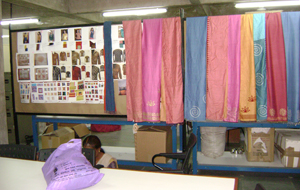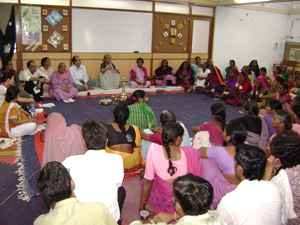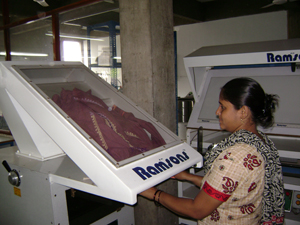![]() Office Depot is offering a “bail-out” for small businesses in its “rescue plan” contest and we were lucky enough to be selected as one of the winners. The company has launched a new website, www.survivalofthesmartest.com Office Depot is recognizing 500 small businesses nationwide for their smart survival strategies and award each with a $1,300 Office Depot Gift Card, tech support for a year from Office Depot’s Tech Depot Services, and copy, print and ship services from Office Depot’s Design, Print, and Ship center with a total prize value of over $2,000. We would like to thank the company for its generosity towards us in this challenging economy!
Office Depot is offering a “bail-out” for small businesses in its “rescue plan” contest and we were lucky enough to be selected as one of the winners. The company has launched a new website, www.survivalofthesmartest.com Office Depot is recognizing 500 small businesses nationwide for their smart survival strategies and award each with a $1,300 Office Depot Gift Card, tech support for a year from Office Depot’s Tech Depot Services, and copy, print and ship services from Office Depot’s Design, Print, and Ship center with a total prize value of over $2,000. We would like to thank the company for its generosity towards us in this challenging economy!
Archive for the ‘Entrepreneurship’ Category
Survival of the Smartest
Wednesday, September 16th, 2009Self-Employment Becomes the Only Option for Many
Sunday, September 13th, 2009With 6.9 million jobs eliminated this year, many unemployed workers are trying to reverse their fortunes by starting their own businesses, either as solo entrepreneurs or by purchasing a franchise. According to the quarterly Job Market Index of outplacement company Challenger Gray & Christmas, 8.7% of the unemployed who found work in the second quarter of this year did so by starting their own businesses, up from 6.4% in the first quarter. But the figures commingle businesses with paid employees with self-employed people who incorporate, the latter representing 75% of all small businesses. Unfortunately, the odds are not on their side; according to the U.S. Small Business Administration’s Office of Advocacy, 50% of new businesses will fail in the first five years. That is in normal times, and we are right now in a difficult recession. The National Small Business Association reports that 60% of small businesses reported declining revenues over the past 12 months, the first time a majority of respondents cited declining revenues since the polling question was first posed in 1993. At the same time, business bankruptcies have nearly doubled over the past two years. Self-employment and entrepreneurship involve significant risks and at least some modest investment. As such, they are not viable alternatives to lack of opportunities in the formal job market.
Senior Entrepreneurs?
Saturday, July 11th, 2009If you think that the most entrepreneurial generation are the twenty-somethings starting businesses in their college dorm rooms, think again. The Public Policy Institute of the American Association of Retired Persons reports that last year, 21% of self-employed Americans were between the ages of 55 and 64, while 10% were ages 65 and older. This trend may accelerate as Baby Boomers find that they lack the financial resources to support them in retirement. Mercer reported that the stock market decline’s consequence on retirement savings accounts was to extend by nine years planned retirements. And this is a generation not known for delayed gratification or savings, so they were inadequately provisioned to begin with. But this trend began long before the 2008 market decline. A 2005 study by the Center on Aging & Work/Workplace Flexibility at Boston College found that workers 50 and older are more likely than younger adults to own their own businesses. I have mixed views on this subject. Certainly, I am all in favor of entrepreneurship. But that process is all about managing risk. If you lose your job, you lose your income. If your small business fails, as most small businesses do, you lose both your income and an asset: your equity in the business. At least with corporate employment, you can diversify your risk, if you wisely choose to invest your 401k and other retirement accounts in assets other than the company stock of your employer. In addition, when you start a new business, you often have to provide personal guarantees for various obligations, such as office leases. This puts your other assets, potentially your home, at risk. Finally, a 20-something entrepreneur has years to catch up on earnings if the business flounders. An older one doesn’t have the luxury of time. Entrepreneurship is a personally rewarding experience for creative expression. But it is not a panacea for inadequate retirement savings.
Small Business Bankruptcy Filings Surge
Thursday, July 9th, 2009According to Equifax, the rate of bankruptcy filings among small businesses is skyrocketing; on average, 350 new filings per day, an increase of 52% as compared with the previous year. Part of the problem is the trickle down effect, as when large corporations such as General Motors file for bankruptcy, they cancel contracts and discharge debts they owe to their suppliers. The 2005 revisions to bankruptcy laws are much tougher on small businesses than on larger corporations, which are often the genesis of the small business’ financial difficulties! Even worse, in today’s tough economy, even those corporations that are going concerns are often in arrears in paying their suppliers. According to the Equifax bankruptcy study, the largest run-up in bankruptcy filings is driven by the transportation industry, which includes the troubled automobile and airlines businesses. The transportation industry is followed by the construction, manufacturing and retail industries. The stress can be seen in local trends, with small business bankruptcy filings increasing the most in Los Angeles and Chicago. Local unemployment is a major contributor to small business bankruptcies. Lack of access to credit appears to be accelerating the trend, as small businesses can no longer borrow working capital until times improve. Small businesses that supply discretionary services, such as restaurants, child-care facilities and entertainment, are at particular risk as consumers cut back such expenses in a recession. Rising prices, particularly in core commodities, such as gas and food, are contributing to the problem. And fewer people are starting new small businesses to replace the failed ones. For small businesses that see no way forward, a Chapter 7 bankruptcy allows for an orderly liquidation and discharge of debt. If it is possible to reorganize the business or sell it as a going concern, Chapter 11 may be the better option. These are tough times, indeed.
Life In the Entrepreneurial Forest
Thursday, July 2nd, 2009Virgin Atlantic Founder Richard Branson had a creative way of describing the phenomenon of creative destruction, the memorable phrase of economist Joseph Schumpeter. He empathized with the pain of employees of British Airways who are forfeiting one month without pay in order to preserve employment at this difficult time. However, he noted that in the forest, old shoots are allowed to die such that new saplings may grow. Absent a compelling threat of systemic risk, such as a legitimate banking crisis, Branson sees government intervention as counter-productive. It simply delays the inevitable, at tremendous cost to the taxpayers, for which our as-yet-unborn great-grandchildren will be paying. And it suppresses or raises the cost of innovation which could provide better services and new jobs. Branson’s interview was thoughtful and we can only hope that policymakers listen to this very articulate and successful entrepreneur.
Opportunity Arises
Saturday, June 6th, 2009Much of the business media focus on the usual platitudes around managing in a recession: now is a good time to start a new business because inputs are less expensive, many great businesses were started in economic downturns, etc. I am not sure I agree with that thinking; in a booming economy, you can keep your cash flow stable with regular employment while preparing to launch your business. In the current environment, you have fewer opportunities to diversify your risk. And you are trying to sell new products and services at a time when everyone else is cutting back. I don’t mean to be negative. I am an optimist, but those who have never before launched small businesses seriously underestimate the risk and stress involved. You need to temper your optimism with a realistic plan to manage through tough times. But I do see two very attractive opportunities that have been overlooked.
The first concerns the unmet needs here at home. I was stunned to learn that the U.S. exports only 10% of its Gross Domestic Product. China exports 10% of its GDP to the U.S. alone, a single export market. The U.S., alone among world economies, can have a home-grown recovery. In recent years too much of our labor force has been focused on what I call “spam” products: mass distribution to see what sticks with negative value-added. Like the mortgage brokers qualifying borrowers for loans that they could not reasonably expect to service, it was all phoniness. But we have some very real social needs and there are opportunities for wealth creation and social enterprise for those who can innovate to meet those needs. That is what I hope to do with Prepared Small Business. The second opportunity concerns the challenges of working in a credit-constrained world. We make better decisions in times of scarcity. In times of abundance, every idiotic idea gets funded. But when we have to make tough capital allocation decisions, we think more carefully about our commitments. This is what separates the passionate entrepreneurs from the dilettantes and what, I believe, will help us to develop solutions to our most pressing needs – not cheap inputs in an economic downturn, but higher value-added solutions.
No Thanks, We’ll Take Care of It Ourselves
Monday, April 13th, 2009Polihale State Park on the Kauai Island of Hawaii has been closed since last December when severe flooding destroyed the access road to the park and damaged other facilities. Hawaii’s Department of Land and Natural Resources estimated that it would cost $4 million to repair the road and other facilities and that it would likely take two years to secure the necessary funding and complete the work. The delays threatened the existence of the small businesses that rely on park access, such as small businesses that operate kayak tours, photography businesses and food service businesses. So the affected small businesses and local residents contributed machinery and manpower and began and completed the repair work within eight days – for free. When I read of their extraordinary work, it reminded me of the importance of learning from the experiences of our peers in the small business community. In Prepare for the Worst, Plan for the Best: Disaster Preparedness and Recovery for Small Businesses (Wiley, second edition, 2008), I cited the example of small businesses in Europe that relied on access to a local theme park to operate. Their restaurants and other concessions were at risk when the theme park could not recover quickly from a major disaster, underscoring the importance of business interruption coverage. Entrepreneurs in Hawaii came up with an even better solution.
Inspiration from India, Part III
Saturday, April 11th, 2009The greatest inspiration I drew from my meetings with women entrepreneurs in India occurred during the “visioning” exercise. As new members join SEWA, they participate in facilitated training sessions to identify their means of self-employment (such as needlework, growing vegetables in small plots of land, paid childcare in their homes for other workers and other home-based businesses). The training sessions help them to build the skills required for the success of their businesses, such as budgeting, a challenge for many members who are illiterate. (The ATM’s of SEWA bank have graphic icons for illiterate users and are hugely popular with members, who are some of the most enthusiastic adopters of technology I have ever met.)
At the last of the training sessions, the group participates in a “visioning” exercise. Each member shares her vision for a better future. For women mired in extreme poverty, envisioning a better future is a challenge. Their lives are spent on tasks for basic survival. But with the encouragement of the other members of the group, each woman, often in a very shy, reluctant manner at first, begins to articulate her dream for the future: perhaps a new roof for her shanty, or a new well for fresh water or other amenities that her increased income can provide her household.
And the dream always includes an education for her children, as her first priority is to pay the school fees to invest in a better future for the next generation. By the time the session is over, everyone is in tears as we each imagine what a better future would look like for the families of women entrepreneurs. I am sure that in these difficult economic times, that is what sustains each of us.
Lessons Learned from India, Part II
Friday, April 10th, 2009The second of SEWA’s two for-profit businesses develops clothing for women and children, using traditional Indian designs. SEWA is fully vertically integrated, with SEWA businesses doing everything from designing the clothing to weaving the fabric to sewing the garments.
SEWA is achieving change on a significant scale. In just the western Gujarat State, SEWA has 500,000 members. More than 100,000 women are policyholders in SEWA’s health and life insurance plans. SEWA bank has 350,000 depositors and, like most microfinance organizations, a very high repayment rate of 97 percent on loans ranging from $100 to $1,100, on which members pay an average interest rate of 15 percent. SEWA’s loan portfolio is entirely funded by the deposit savings of its members.
Many SEWA members also grow vegetables on their small plots of land which they sell, either to agribusinesses for processing or directly to consumers, such as from this SEWA kiosk. At the annual meeting of the SEWA cooperative members, which I had the privilege of attending, SEWA’s iconic founder, Ela Bhatt, outlined her vision for the future of SEWA members. At age 76, Ela continues to innovate to ensure that the poor women who are SEWA members capture a fair share of India’s expanding economy. She urged SEWA members to consider capturing the value of SEWA-branded agricultural products rather than selling nameless commodities for which other processors would capture higher rents.
The strategy for branding SEWA is impressive for its sophistication and its mission of improving the lives of SEWA members. This was the second of the lessons I took away from my exchange with women entrepreneurs in India: our common need to capture the value we create in fair pricing. We work too hard to see these margins captured by other players in the supply chain.
Lessons Learned from India, Part 1
Thursday, April 9th, 2009A recent article in the New York Times reminds me to share three of the lessons I learned during exchanges with women entrepreneurs from India. The second annual International Women’s Entrepreneurial Challenge (IWEC) was held last June here in New York. The competition celebrates outstanding female-led small businesses that are expanding on a global basis. Mine was one of the three women-owned small businesses selected to represent the U.S. in the IWEC program. Three women-owned small businesses were selected from each of the other participating regions: Spain (Barcelona), India and Africa. We had three very full days together, including a case study taught by IESE Business School (Barcelona) Professor Paddy Miller and a luncheon at the Indian Consulate in New York. The photograph shows the panel of our luncheon speakers, including Ambassador Ruth Davis of the U.S. State Department. Our hostess, Ambassador Neelam Dao, Consul General of India in New York, was an excellent speaker and unusually candid for a diplomat. She remarked about the embarrassment of Wall Street titans having to go to sovereign wealth funds of “third world countries” (remember this was in June of 2008, before the collapse of Lehman Brothers) for bailouts after they had enriched themselves while mismanaging their institutions. She added that in finance it is usually “last in, first out” and worried about the fate of smaller women-owned enterprises and microfinance clients who would, she correctly predicted, be unable to access financing to continue to grow their businesses, notwithstanding the fact that their businesses, our businesses, are sustainable and provide broad benefits to the world economy. I could not have agreed with her more and was delighted with her frankness.
I was even more delighted to read the report in the New York Times of the operations of SEWA, the Self-Employed Women’s Association. I had the occasion to visit SEWA in Ahmadabad, India, when I served as the Senior Policy Advisor to a program of the United Nations Capital Development Fund. SEWA is a network of more than 100 Gandhian-style, women-owned and led cooperatives, which do everything from offer childcare to sell produce to Indian agribusinesses for processing. (Gandhi’s ashram is also located in Ahmadabad.) Like more than 90% of Indians, SEWA members are employed in the informal economy, where most earn less than twenty cents a day and have no social safety net. They are vulnerable to what economists call “external shocks”, an antiseptic term for life’s calamities, such as illness or unemployment, for which they have no protection.
SEWA’s microfinance institution extends to credit to allow women in the slums to build small businesses, such as hair salons. It also offers retirement accounts and health insurance to the SEWA members to give them some protection against the unexpected, job training to enter non-traditional fields (such as women gas station attendants) and distribution of the handcrafted products of SEWA members to major retailers.
Pride in SEWA is shown in the flower petals arranged in the form of the SEWA logo and colors to welcome visitors. SEWA’s Trade Facilitation Centre supports two for-profit businesses that develop and sell traditional needlework products, an art passed from mother to daughter in the state of Guarat in India. SEWA develops designs that their marketing research show appeal to consumer tastes and then distribute these design imprints with individually packaged needle kits, containing all necessary supplies, to participating SEWA members. The members do the needlework in their homes, while tending to their small plots of land, caring for their children or elderly parents or raising a few small animals for feed.
The finished products are brought to the SEWA Trade Facilitation Centre for processing, where they are spun dry, to remove any dust or particles they may have acquired, and properly cleaned. They are then sent to SEWA retail shops in New Delhi and Ahmadabad for sale to consumers. SEWA hopes to have an e-commerce site available in the near future.















